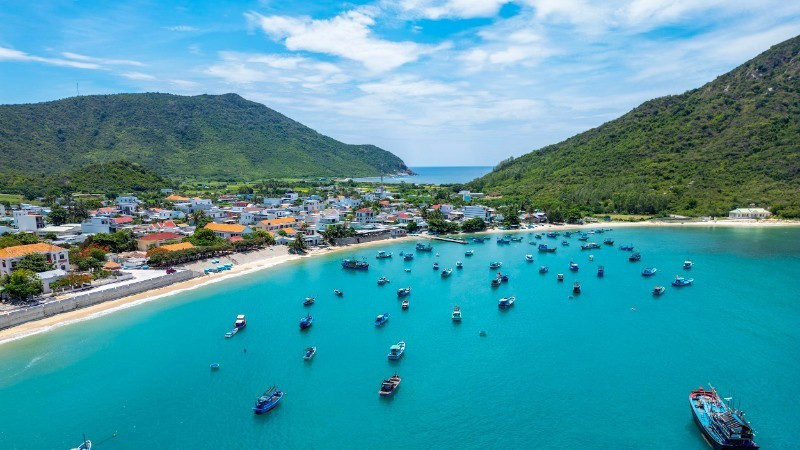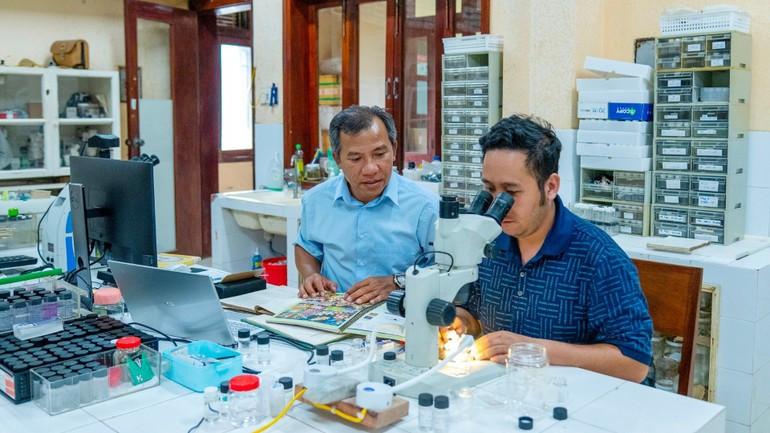National maritime aspirations
Understanding and mastering the sea to fully take advantage of its value and role in natural resource exploitation and national sovereignty protection.

Viet Nam ranks among the world’s top 10 countries with the longest coastline, at over 3,260km (excluding islands), opening out in three directions: east, south, and west. Efforts to understand and master the sea to make the best use of its value and role in natural resource exploitation while protecting national sovereignty have been carried out for over a hundred years by the Institute of Oceanography — a pioneering agency in oceanographic research and in investigating resources and environment in the East Sea/South China Sea.
The 21st century is known as “the century of the seas and oceans.” Resolution No. 36-NQ/TW (dated October 22, 2018), issued by the Party Central Committee on the strategy for the sustainable development of Viet Nam's marine economy to 2030, with a vision to 2045, clearly states the goal for 2045: “Viet Nam will become a powerful marine nation, with sustainable, prosperous, secured, and safe development.” One of the key breakthroughs identified is “the development of marine science and technology and the training of high-quality marine human resources, promoting innovation, taking advantage of advanced scientific and technological achievements, and new science and technology.”
People behind the scenes
The ocean is immense, but to study it, scientists must start from the smallest things, such as analysing life in each drop of seawater. Perhaps for this reason, the first person the Institute of Oceanography arranged for me to meet was Prof. Dr. Doan Nhu Hai, Chairman of the Scientific Council, who has been with the institute since 1993. He is an expert on plankton — tiny organisms that form the foundation of the marine ecosystem. In a gentle, deliberate voice, he carefully explained why they are the very core of the ocean.
Covering more than 70% of the Earth’s surface, the sea is much larger than human living space, especially when depth is considered. Before assessing any marine area, one must evaluate how the planktonic system operates, how it interacts with other factors, and whether it offers the optimal conditions for exploiting marine resources (such as aquaculture or fisheries). Specifically, one narrow field of phytoplankton research is harmful algae, the area to which Prof. Dr. Doan Nhu Hai has devoted much of his time and passion. Algae are invisible to the naked eye and cannot swim independently, but they are everywhere. Besides abnormal phenomena such as “bloom” replication (red tide phenomena), causing toxin accumulation, oxygen depletion, and threatening other life in the waters. Harmful algae can also accumulate in aquatic species, potentially affecting human health over time through the food chain.
In 1991, the European Union (EU) issued strict regulations on importing bivalve molluscs from Viet Nam, including requirements for toxic/harmful algae monitoring programmes, which halted exports of these products. In 1997, the Institute of Oceanography, including Prof. Dr. Nguyen Ngoc Lam and Prof. Dr. Doan Nhu Hai, supported the Food Safety Centre of the former Ministry of Fisheries in training and developing a team while also establishing a standard laboratory for monitoring process. EU representatives visited in October 1999, confirming that Viet Nam had enough capacity to test and monitor toxic/harmful algae.
“In November 1999, the EU decided to recognise valid procedures, paving the way for our bivalve mollusc exports to resume. We were very proud. We may stand behind, unknown to anyone. Our work supports someone, somewhere, on some issue, without being tied to any one place, because all life processes are interconnected in one way or another. But we are truly happy knowing we have done it,” Prof. Dr. Doan Nhu Hai shared.
Conservation for development
Viet Nam’s current marine economic development strategy cannot be separated from the foundations of green growth, biodiversity, and marine ecosystem conservation.
“One of the institute’s upcoming directions is to effectively implement programmes to protect coral reef ecosystems, seagrass beds, and mangrove forests; to manage and protect spawning grounds and breeding areas. Protecting spawning and nursery grounds for valuable species must be prioritised and implemented through the establishment of aquatic seed resource conservation zones,” shared Assoc. Prof. Dr. Dao Viet Ha, Director of the Institute of Oceanography.
Responding to practical demands, the Institute of Oceanography has been conducting scientific research to sustainably exploit, manage, and develop marine resources and protect the marine environment in localities, as well as expanding new aquaculture species to serve livelihoods and exports.

Having worked at the institute for over 32 years, Assoc. Prof. Dr. Nguyen Van Long is an expert in coral reefs and marine conservation. With the strong, jovial manner of a coastal native, he said Viet Nam currently has 16 marine protected areas, 12 of which are operational. Research by the institute, as well as by Dr. Long personally, has contributed to building profiles and zoning management plans for half of them. As the national coordinator for the Global Coral Reef Monitoring Network (GCRMN) and a member of the International Coral Reef Initiative (ICRI), he has directly trained staff at marine protected areas, updated them on the latest research results and technologies, including AI applications for coral reef monitoring.
Notably, over the past ten years, Assoc. Prof. Dr. Nguyen Van Long was the first person in Viet Nam to propose the need to assess and protect spawning and nursery grounds within marine protected area planning. This is critically important in regenerating fisheries resources and preserving the inherent biodiversity of the regions.
“My viewpoint is that we must safeguard core values, while also accepting some trade-offs, ensuring a balance between conservation and development. We cannot insist on preserving everything if the economy, society, and people’s livelihoods do not improve. To achieve this, restoring ecosystems and key resources is essential. In addition to scientific research results, we must integrate science with local knowledge, turn it into a scientific foundation, from which to make plans and convince managers,” he emphasised.
Recently, the government issued Decision No. 1539/QD-TTg on December 10, 2024, approving a project on expanding and establishing new marine protected areas, aquatic resource protection areas, and restoring marine ecosystems to 2030, ensuring that marine and coastal protected areas cover 6% of Viet Nam’s natural marine area. The work of scientists remains vast. Meanwhile, like many scientific research units, the Institute of Oceanography faces a shortage of young staff and difficulties in recruitment.
Passion is essential
A worrying reality is that Viet Nam does not have any facility providing in-depth training in marine science. Currently, only a few universities offer some related subjects, but none are comprehensive, as oceanography requires knowledge across four main sectors of physical oceanography, marine geology, marine chemistry, and marine biology. Scientists such as Assoc. Prof. Dr. Dao Viet Ha, Prof. Dr. Doan Nhu Hai, and Assoc. Prof. Dr. Nguyen Van Long all graduated in biology, were later recruited by the institute, and then continued to study abroad under international cooperation programmes.
With limited incoming human resources, those recruited must continue their training and undergo professional standardisation and enhancement. The actual workload is demanding due to its sheer volume and the challenges of working at sea, braving wind, rain, and waves — all of which are reasons why the institute is perpetually short of staff. To overcome this, the scientists all share that their work must stem from a love for the sea.
“Our professional duties absolutely require passion, without passion, we could not do this work. That is something special in today’s era, because the income and incentives of this work are not attractive enough to draw in young people. Meanwhile, we must work even harder, as we are lagging behind countries more advanced in this field. Just trying to catch up is exhausting, isn’t it? So where does the motivation come from? Only love and passion can drive us forward!” Prof. Dr. Doan Nhu Hai affirmed.
Without marine research, Viet Nam cannot become a powerful marine nation as set out in its goals. Resolution No. 57-NQ/TW (dated December 22, 2024) by the Politburo on breakthrough development in science, technology, innovation, and national digital transformation is expected to unlock bottlenecks in the development of scientific research human resources.
“Our country is still limited in financial resources, and the scientific community understands this. The issue is whether investment is well-directed and whether it is long-term. In science, it’s hard to guarantee that a project or research direction will be completed within five years. Even if we fail, the lessons learned are valuable and should be seen as research results. Therefore, we hope the new policies of the central agencies and the government will soon come into effect to address existing shortcomings,” Assoc. Prof. Dr. Nguyen Van Long shared.
“The institute’s immediate fundamental solution is to strengthen the training of its existing human resources while seeking young and potential personnel and taking advantages of the programme to attract young scientists to work at the Viet Nam Academy of Science and Technology to supplement personnels,” Assoc. Prof. Dr. Dao Viet Ha said.
This forms the foundation for the institute to continue promoting research in deep-sea and offshore areas, marine forecasting research, focusing on fisheries resource prediction, changes in fishing grounds, coastal and island erosion and accretion, environmental incidents, and the impacts of climate change on coastal regions and islands. The institute’s applied research that has been carried out will undoubtedly prove high effectiveness in serving socio-economic development and technology transfer to localities, businesses, and communities.
With over a century of activity, the Institute of Oceanography is like a lighthouse, quietly illuminating knowledge of the sea day and night. Although the road ahead is still full of challenges, it is precisely the passion and dedication of its scientists who are contributing to building a powerful marine science for the nation.








